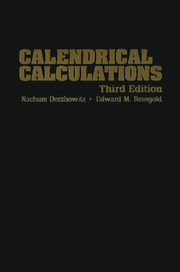Book contents
- Frontmatter
- Dedication
- Contents
- List of Frontispieces
- List of Figures
- List of Tables
- Abbreviations
- Mathematical Notations
- Preface
- Credits
- License and Limited Warranty and Remedy
- About the Cover
- 1 Calendar Basics
- I ARITHMETICAL CALENDARS
- 2 The Gregorian Calendar
- 3 The Julian Calendar
- 4 The Coptic and Ethiopic Calendars
- 5 The ISO Calendar
- 6 The Islamic Calendar
- 7 The Hebrew Calendar
- 8 The Ecclesiastical Calendars
- 9 The Old Hindu Calendars
- 10 The Mayan Calendars
- 11 The Balinese Pawukon Calendar
- 12 Generic Cyclical Calendars
- II ASTRONOMICAL CALENDARS
- III APPENDICES
- Index
- Envoi
- About the Cover
12 - Generic Cyclical Calendars
Published online by Cambridge University Press: 05 February 2014
- Frontmatter
- Dedication
- Contents
- List of Frontispieces
- List of Figures
- List of Tables
- Abbreviations
- Mathematical Notations
- Preface
- Credits
- License and Limited Warranty and Remedy
- About the Cover
- 1 Calendar Basics
- I ARITHMETICAL CALENDARS
- 2 The Gregorian Calendar
- 3 The Julian Calendar
- 4 The Coptic and Ethiopic Calendars
- 5 The ISO Calendar
- 6 The Islamic Calendar
- 7 The Hebrew Calendar
- 8 The Ecclesiastical Calendars
- 9 The Old Hindu Calendars
- 10 The Mayan Calendars
- 11 The Balinese Pawukon Calendar
- 12 Generic Cyclical Calendars
- II ASTRONOMICAL CALENDARS
- III APPENDICES
- Index
- Envoi
- About the Cover
Summary
One who is capable of making astronomical calculations, but does not make them, is unworthy of being spoken to.
—Babylonian Talmud (Sabbath, 75a)In this chapter, we use formulas from Section 1.12 to cast a number of the calendars presented in Part I into a unified framework. Years must be determined by the occurrence of some “critical” mean annual event, like a mean equinox or mean solstice. Months must also follow a uniform pattern. In single-cycle calendars, new years begin on the day the critical annual event happens before (or possibly at) some critical time of day. In double-cycle calendars, months begin on the day of a critical mensual event, and years begin with the month associated with the critical annual event.
Single Cycle Calendars
The wheel is come full circle.
—William Shakespeare: King Lear, Act V, scene iii (1605)There are four “single-cycle” paradigms for calendars, as we independently allow
the determining critical annual event to occur strictly before, or to occur at or before, some critical time of day, and
the pattern of months to follow a fixed yearly pattern, according to equations (1.78)–(1.81) or to follow a mean monthly pattern, in tune with the yearly pattern.
- Type
- Chapter
- Information
- Calendrical Calculations , pp. 163 - 168Publisher: Cambridge University PressPrint publication year: 2007
- 1
- Cited by



